Revell 1/72 scale
C-54D Skymaster
Thunderbirds
by Roland Sachsenhofer
|
C-54D Skymaster "Thunderbirds" |

A C-54 "Skymaster", military descendant of the elegant DC-4 passenger aircraft, is a highly elegant and breathtaking appearance in every way, of that there can be no doubt. The forms of the DC-4 are so timelessly valid that hardly any of the countless coloured versions and military camouflages in which this classic has served for decades could have spoiled the clear lines and powerful, racy forms. On the contrary, some paint jobs even added to the visual appeal!
The C-54 as a Support Aircraft for the Thunderbirds
This certainly includes the design of the logistics aircraft of the legendary aerobatic team of the US Air Force, the "Thunderbirds", shown here. The graphic and colour design takes up the characteristic elements of the Thunderbirds: the colours red, blue and white dominate and are designed in the form of the familiar curved stripes that run in dynamic shapes over the fuselage. In addition, the use of the dark blue stars on the tail unit increases the recognition value and thus the identification with the aerobatic aircraft of this unit designed in the same way.
When one considers that behind the flight demonstrations of the Thunderbirds, in addition to the eight aerobatic pilots in the limelight, there is also an impressive team of well-coordinated technicians, management and press officers, but also administrative staff or, for example, the aeromedical personnel, the importance of well-developed logistics becomes clear.
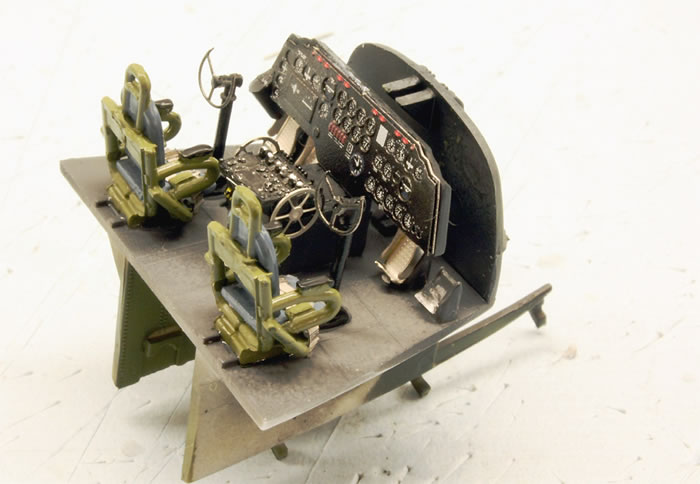
Today, a total of about 130 men and women are deployed on site for the Thunderbirds' worldwide activities. The logistics aircraft is not only used to move the escort personnel, but can also become part of the demonstration. Well-known are, for example, spectacular overflights or, probably even more spectacular, the demonstration of take-off supported by take-off aid rockets in the shortest possible space.
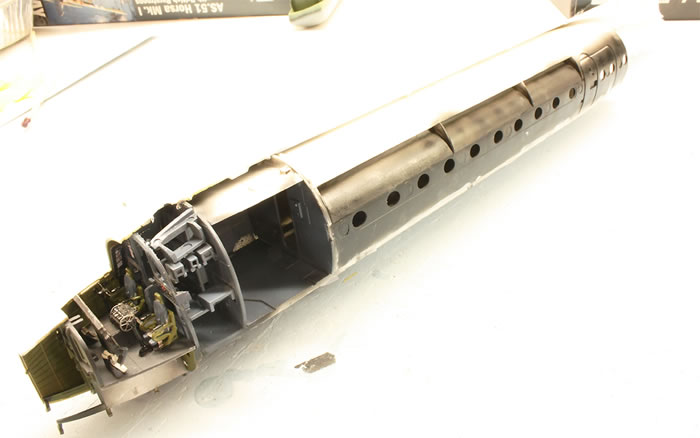
Aerobatic capability is of course not expected from the C-54, its strengths play in a completely different league! With a wingspan of 38.81m and a length of 28.81m, the Skymaster weighs in at 19 310kg. The maximum take-off mass is given as an impressive 33 190kg, which can be moved over a maximum of 6000 kilometres. Four Pratt & Whitney R-2000-25 engines with 1,450 hp each accelerate the elegant aircraft to a maximum of 450 km/h.
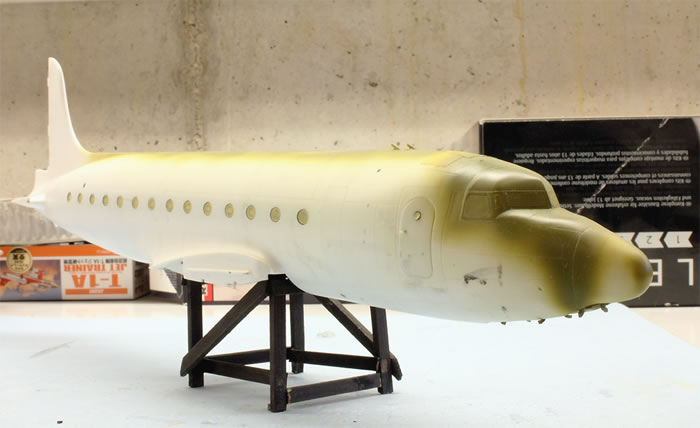
The C-54D shown here was used by the Thunderbirds from the 1961 season. At that time, the famous acrobatic team was just eight years old and, as would soon become apparent, facing difficult and tragic times with the new decade. In the years that this C-54D supported the Thunderbirds, triumph, tragic misfortune and new beginnings were all close together for the acrobatic team.
The USAF "Thunderbirds" Acrobatic Team in the 1960s
Founded in 1953 as the "3600th Air Demonstration Unit" at Luke AFB/ Arizona, one of the unit's principles was to demonstrate top class precision aerobatics using the USAF's most modern operational models. The original name was a disaster for advertising and the PR department, so that the choice of the name of a deity of the indigenous people living in Arizona was considered a stroke of luck: "Thunderbird" actually has a lot of fitting associations! It was all the more appropriate that the first model of the Thunderbirds was the F-84G Thunderjet. Two years later it was exchanged for the F-84 Thunderstreak, which, however, was only to make a brief appearance.
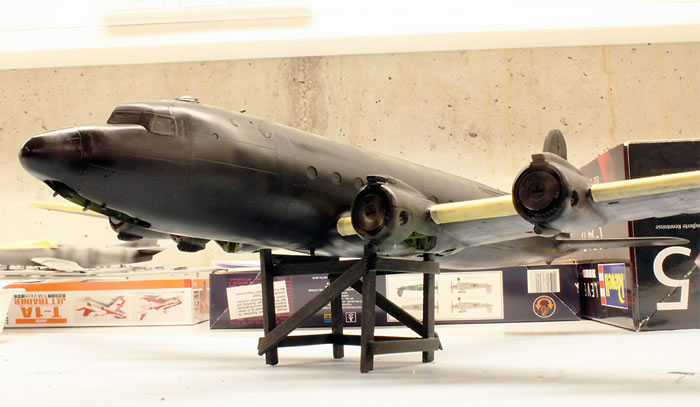
The following year, the F-100D Super Sabre was chosen, which was to mark the beginning of a completely new era for the team. For the first time, the pilots were confronted with a supersonic jet, whose considerable 12-ton weight could be accelerated with an engine of previously unimagined power. These new parameters naturally also posed a challenge for the planning of the air shows. But already the 1956 season, the first flown with the Super Sabre, showed that the Thunderbirds were on the winning track.
Fame rose and the team moved into the top league of the world's best in precision aerobatics. The Thunderbirds were now active worldwide. In the 1959 season alone, over 100 events were held around the globe, showcasing high-speed, top-level aerobatics to an incredible 10 million spectators.
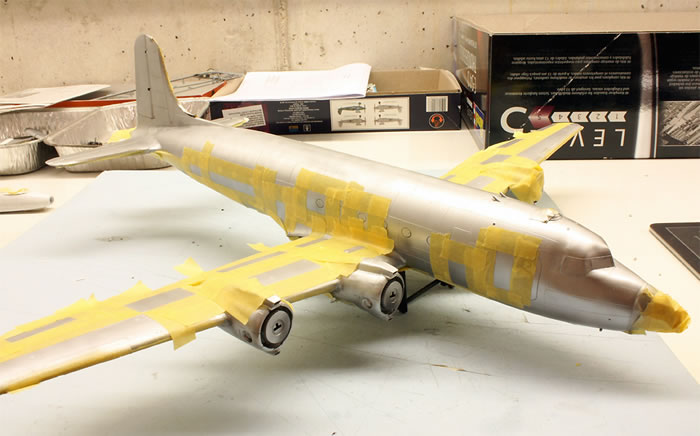
The year 1964, on the other hand, must be considered a black year in the team's history. Although the introduction of the F-105B Thunderchief brought "thunderbirds" back into the Thunderbirds' nest, the resulting increase in performance was not to be good business this time. The huge Thunderchief, a behemoth weighing 23 tonnes, with an unbearably loud engine, powerfully fast, ponderous and sluggish, demanded everything from the pilots and the choreographers during the demonstrations. Too much, as it turned out.
On 9 May, during a flight demonstration, one of the F-105s involved broke up in mid-air, killing the pilot. The forces involved had proved too great; the Thunderchief simply could not be forced into the role of an acrobatic aircraft operating in a relatively small space. Misfortune caught the Thunderbirds on the left foot to boot. Against the background of the US involvement in Vietnam, which was just approaching its first peak, and a drop in popularity, there was even talk of disbanding the unit.
In the 1965 season, the company returned to the tried and tested F-100D - and apparently also found its way back to proven form. With 121 shows in 23 countries, it reached nearly seven million viewers again that year. The popularity and popularity of the Thunderbirds would never again suffer such a deep slump as in the crisis year of 1965.

The decade under review ended with another controversial type change: in 1968, the Thunderbirds finally bid adieu to the tried and tested F-100 Super Sabre and worked their way up to a new type: the F-4 Phantom. Although fears that the heavy and powerful F-4 would repeat the events surrounding the unfortunate choice of the F-105 were not entirely unfounded, they fortunately did not come true. This should make history all the more exciting, as the stories written by the world-famous US acrobatic team from the early 1970s onwards. But that, as they say, is really another story.
Revell really puts something worth seeing in the big box here, the opulent detailing enchants in almost all areas! Although this splendour will disappear from the fuselage when it is closed, I really don't want to criticise that. A certain tendency towards "over-engineering" cannot be denied in the kit.
This sometimes makes the construction unnecessarily time-consuming and also leads to many a problem: I would like to mention here above all the complex construction of the engine nacelles. Without me being able to see what would be gained by this, parts over parts have to be glued together. The manageability but also the accuracy of fit of the final product suffers greatly and leads to costly rework.
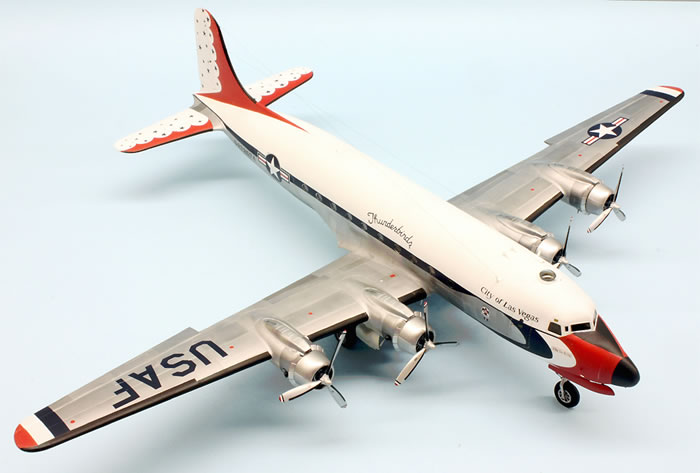
By the way, I would like to raise an objection to the bright white polystyrene that Revell always likes to use. In the good lighting of a workbench it is so bright and contourless that orientation is difficult. During the construction period I longed for grey, green or brown material!
But wait: actually I wanted to praise! In all other categories I find Revell's large C-54 Skymaster simply tops. Especially in the Platinum Edition this kit is a guarantor for a long and rewarding building pleasure.
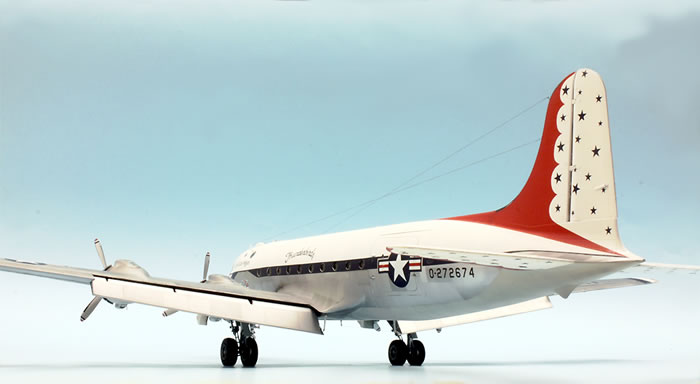
Finally, the decals must be mentioned: these meet the high expectations that one may have of Revell's decal sheets. Especially the credibility of the "paint job" of this C-54 variant stands and falls with the quality of the decals, as they have to be applied over a large area. Revell deserves the highest praise: the decals can be applied without any problems, the carrier film finds a wonderful balance between strength and fineness of the material thickness.
To give an idea of the effort Revell puts into detailing: It is necessary to apply five individual markings per propeller blade. That makes 15 individual decals for a propeller set - 60 individual, fine decals were used for the design of the four propellers alone!
In conclusion, I can say that Revell has expertly and in great detail prepared a model building pleasure that will entertain for a long time and that should provide enjoyable experiences for all model building enthusiasts, except perhaps those in a hurry- Last but not least: the display case is enriched by a really colourful bird!
If you are interested in the building process, please have a look here on Scalemates:
https://www.scalemates.com/profiles/mate.php?id=10148&p=albums&album=66901
As ever, remarks will be appreciated: ro.sachsenhofer@gmx.at
Model, Images and Text Copyright ©
2021 by Roland Sachsenhofer
Page Created 1 July, 2021
Last Updated
1 July, 2021
Back to HyperScale Main Page

|
Home
| What's New | Features | Gallery | Reviews | Reference | Resource Guides | Forum |